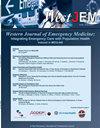Impact of Bystander Cardiopulmonary Resuscitation on Out-of- Hospital Cardiac Arrest Outcome in Vietnam
IF 1.8
3区 医学
Q2 EMERGENCY MEDICINE
引用次数: 0
Abstract
Introduction: Patients experiencing an out-of-hospital cardiac arrest (OHCA) frequently do not receive bystander cardiopulmonary resuscitation (CPR), especially in low- and middle-income countries (LMIC). In this study we sought to determine the prevalence of OHCA patients in Vietnam who received bystander CPR and its effects on survival outcomes. Methods: We performed a multicenter, retrospective observational study of patients (≥18 years) presenting with OHCA at three major hospitals in an LMIC from February 2014–December 2018. We collected data on the hospital and patient characteristics, the cardiac arrest events, the emergency medical services (EMS) system, the therapy methods, and the outcomes and compared these data, before and after pairwise 1:1 propensity score matching, between patients who received bystander CPR and those who did not. Upon admission, we assessed factors associated with good neurological survival at hospital discharge in univariable and multivariable logistic models. Results: Of 521 patients, 388 (74.5%) were men, and the mean age was 56.7 years (SD 17.3). Although most cardiac arrests (68.7%, 358/521) occurred at home and 78.8% (410/520) were witnessed, a low proportion (22.1%, 115/521) of these patients received bystander CPR. Only half of the patients were brought by EMS (8.1%, 42/521) or private ambulance (42.8%, 223/521), 50.8% (133/262) of whom had resuscitation attempts. Before matching, there was a significant difference in good neurological survival between patients who received bystander CPR (12.2%, 14/115) and patients who did not (4.7%, 19/406; P < .001). After matching, good neurological survival was absent in all OHCA patients who did not receive CPR from a bystander. The multivariable analysis showed that bystander CPR (adjusted odds ratio: 3.624; 95% confidence interval 1.629–8.063) was an independent predictor of good neurological survival. Conclusion: In our study, only 22.1% of total OHCA patients received bystander CPR, which contributed significantly to a low rate of good neurological survival in Vietnam. To improve the chances of survival with good neurological functions of OHCA patients, more people should be trained to perform bystander CPR and teach others as well. A standard program for emergency first-aid training is necessary for this purpose.旁观者心肺复苏对越南院外心脏骤停结果的影响
导言:经历院外心脏骤停(OHCA)的患者通常不会接受旁观者心肺复苏(CPR),尤其是在中低收入国家(LMIC)。在这项研究中,我们试图确定越南接受旁观者心肺复苏的院外心脏骤停患者的发病率及其对生存结果的影响。方法:我们对 2014 年 2 月至 2018 年 12 月期间在一个 LMIC 的三家主要医院就诊的 OHCA 患者(≥18 岁)进行了一项多中心、回顾性观察研究。我们收集了有关医院和患者特征、心脏骤停事件、紧急医疗服务(EMS)系统、治疗方法和结果的数据,并在接受旁观者心肺复苏和未接受旁观者心肺复苏的患者之间,对这些数据进行了配对前和配对后的 1:1 倾向性评分匹配。入院后,我们通过单变量和多变量逻辑模型评估了出院时神经系统存活率高低的相关因素。结果显示在 521 名患者中,388 名(74.5%)为男性,平均年龄为 56.7 岁(SD 17.3)。虽然大多数心脏骤停(68.7%,358/521)发生在家中,78.8%(410/520)有目击者,但这些患者中接受旁观者心肺复苏的比例很低(22.1%,115/521)。只有一半的患者是由急救中心(8.1%,42/521)或私人救护车(42.8%,223/521)送来的,其中 50.8%(133/262)的患者尝试过复苏。匹配前,接受旁观者心肺复苏的患者(12.2%,14/115)与未接受旁观者心肺复苏的患者(4.7%,19/406;P < .001)在神经系统存活率方面存在显著差异。经过匹配后,所有未接受旁观者心肺复苏的 OHCA 患者都没有良好的神经存活率。多变量分析表明,旁观者心肺复苏(调整后的几率比:3.624;95% 置信区间:1.629-8.063)是预测良好神经存活率的独立指标。结论在我们的研究中,仅有 22.1% 的 OHCA 患者接受了旁观者心肺复苏术,这也是越南神经系统存活率较低的重要原因。为了提高 OHCA 患者神经功能良好的存活率,应培训更多的人进行旁观者心肺复苏术,并教导其他人。为此,有必要制定一个标准的急救培训计划。
本文章由计算机程序翻译,如有差异,请以英文原文为准。
求助全文
约1分钟内获得全文
求助全文
来源期刊

Western Journal of Emergency Medicine
Medicine-Emergency Medicine
CiteScore
5.30
自引率
3.20%
发文量
125
审稿时长
16 weeks
期刊介绍:
WestJEM focuses on how the systems and delivery of emergency care affects health, health disparities, and health outcomes in communities and populations worldwide, including the impact of social conditions on the composition of patients seeking care in emergency departments.
 求助内容:
求助内容: 应助结果提醒方式:
应助结果提醒方式:


